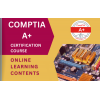Primary tabs
Naveenkumar1412
The CompTIA A+ Certification Training prepares candidates for the CompTIA A+ certification exams, which validate foundational IT skills. Here’s a detailed guide to what the training entails:
Course Content Overview
Hardware:
Components: Learn about various hardware components such as CPUs, RAM, motherboards, power supplies, and storage devices.
Installation and Configuration: Techniques for installing and configuring PCs, laptops, and peripherals.
Troubleshooting: Methods for diagnosing and repairing hardware issues.
Networking:
Network Types and Standards: Understanding LAN, WAN, PAN, and MAN networks, and different networking standards.
Configuration: Setting up and configuring routers, switches, and wireless access points.
Troubleshooting: Identifying and resolving network issues, understanding IP addressing and DNS.
Mobile Devices:
Operating Systems: Features and functions of mobile operating systems like iOS and Android.
Setup and Configuration: Configuring laptops and mobile devices, including synchronization and backup.
Troubleshooting: Common issues and solutions for mobile devices.
Operating Systems:
Windows: Installation, configuration, and maintenance of Windows OS.
Other OS: Basic knowledge of macOS, Linux, and mobile operating systems.
Troubleshooting: Identifying and resolving OS-related issues.
Security:
Threats and Vulnerabilities: Understanding malware, social engineering, and other security threats.
Best Practices: Implementing security measures, securing devices and networks.
Troubleshooting: Recognizing and addressing security issues.
Software Troubleshooting:
Applications: Installing, configuring, and troubleshooting various software applications.
Diagnostic Tools: Using diagnostic tools and utilities to resolve software issues.
Operational Procedures:
Safety: Best practices for personal and environmental safety.
Documentation: Importance of proper documentation and change management.
Professionalism: Effective communication and professionalism in IT.
Training Formats
Instructor-Led Training: Classroom or virtual instructor-led sessions provide interactive learning experiences.
Self-Paced Online Courses: Flexible online modules that can be completed at the learner’s own pace.
Boot Camps: Intensive, short-term training programs focusing on rapid preparation.
Hands-On Labs: Practical labs and simulations to provide real-world experience.
Recommended Study Resources
Official CompTIA Study Guides: Comprehensive books covering exam objectives.
Online Learning Platforms: Websites like Coursera, Udemy, and Pluralsight offer CompTIA A+ courses.
Practice Exams: Mock exams to simulate the test environment and identify areas for improvement.
Flashcards and Study Apps: Tools for quick review and reinforcement of key concepts.
Certification Exam Details
Exam Codes: Core 1 (220-1101) and Core 2 (220-1102).
Format: Multiple-choice, drag-and-drop, and performance-based questions.
Duration: 90 minutes per exam.
Passing Scores: 675 for Core 1, and 700 for Core 2 (on a scale of 100-900).
Benefits of Certification
Industry Recognition: Validates essential IT skills and knowledge, recognized globally.
Career Advancement: Opens doors to entry-level IT roles and provides a foundation for further certifications.
Skill Development: Comprehensive understanding of IT fundamentals and practical problem-solving abilities.
Would you like information on specific training providers or additional resources for preparing for the CompTIA A+ certification?
https://www.sprintzeal.com/course/comptia-certification-training/mumbai




